Deadpool and Cable might not be the best of friends, but that doesn’t stop Marvel from teaming up the unlikely duo again and again. This time instead of going with the classic idea of putting the pair into a book under the moniker Cable & Deadpool, Marvel placed Deadpool’s name first in Deadpool & Cable: Split Second. […]
Viewing: Blog Posts Tagged with: witches, Most Recent at Top [Help]
Results 1 - 25 of 46
Blog: PW -The Beat (Login to Add to MyJacketFlap)
JacketFlap tags: Comics, Marvel, Breaking News, Publishers, Brown, Cable, Top News, Deadpool, Top Comics, Nicieza, Add a tag
Blog: Galley Cat (Mediabistro) (Login to Add to MyJacketFlap)
JacketFlap tags: Publishing, Lego, Brown, Little, Add a tag
Little, Brown Books for Young Readers has teamed up with LEGO for a new series of graphic novels aimed at young readers and writers.
The two companies signed a multi-book, multi-year agreement to produce numerous LEGO-themed books aimed at readers ages 6 – 11. Little, Brown Books for Young Readers will launch a LEGO line with graphic novels based on three different bestselling LEGO properties: LEGO Ninjago, LEGO Friends and LEGO BIONICLE. Rex Ogle, Senior Editor at Little, Brown, will edit the books.
The first titles will come out in time for the holidays this year and will cost $7.99.
Add a Comment
Blog: The Write Words (Login to Add to MyJacketFlap)
JacketFlap tags: Kevan Lyon, Kate McKean, Sangeeta Mehta, self-publishing, Brown, Jane Friedman, Little, Simon & Schuster, Add a tag
 It's difficult for any writer to get published by a traditional publisher, whether you write for adults or for children. That's why more writers than ever are turning to self-publishing. But before you jump on the bandwagon, especially if you write for children, it's helpful to find out more about self-publishing.
It's difficult for any writer to get published by a traditional publisher, whether you write for adults or for children. That's why more writers than ever are turning to self-publishing. But before you jump on the bandwagon, especially if you write for children, it's helpful to find out more about self-publishing.Check out the recent post by guest blogger Sangeeta Mehta on publishing expert Jane Friedman's blog. Mehta, a former acquiring editor of children's books at Little, Brown and Simon & Schuster who runs her own editorial services company, interviewed agents Kate McKean and Kevan Lyon for answers to key questions on self-publishing children's books.
What do you think about the pros and cons of self-publishing? Please share your experiences.
Blog: OUPblog (Login to Add to MyJacketFlap)
JacketFlap tags: Language, Oxford Etymologist, brown, word origins, etymology, anatoly liberman, gleanings, *Featured, hull gull, livid, one as pronoun, overuse of over, Books, Add a tag
It so happened that at the end of this past summer I was out of town and responded to the questions and comments that had accumulated in August and September in two posts. We have the adjectives biennial and biannual but no such Latinized luxury for the word month. Although I realized that in this case bimonthly would be misleading, I hoped that the context would disambiguate it. Let me assure our correspondents that my gleanings will keep appearing every last Wednesday until some unpredictable circumstance (for example, a sudden lack of queries: I can’t think of anything else) do us part. My bimonthly meant “gleanings for two months.”
Etymologies
Gaul, Walloon, Wallachian
Wallachian, Walloon, and Welsh share the same Germanic root, which means “foreign” (one can also see it in walnut, as well as in the family names Wallace, Welsh, and Walshe). The Anglo-Saxons called the Celts and the Romans foreigners. The element -wall in Cornwall is related to them. Gaulish is a Romanized form of the same adjective (compare ward and guard, Wilhelm and Guillaume). But one should not argue from etymological affinity to tribal or national identity. Calling some people foreigners does not say anything about their origin.
Hull gull
Dictionary of American Regional English (DARE) has an entry for the word, and descriptions of the game abound, but the origin of the name remains undiscovered. My browsing has not yielded anything worth reporting. What little has been said on the subject in books on games can be found on the Internet in five minutes. The idea that hull goes back to the Old Engl. verb for “hide” (hellan ~ helian, in Modern English, rare and dialectal hele; compare German hehlen, hüllen, and their cognate -ceal in Engl. conceal, from Latin, via French) is, in my opinion, fanciful. Hull gull is known among American Indians, but in the absence of its native name nothing follows from this fact. The hully gully dance seems to have been called after the game. Some people have looked for its source in Africa, yet no facts bear out its African origin. In my experience, the nucleus of such reduplications (hugger-mugger and the like) is more often the second element; the first is then added to rhyme with it. This is especially true of the words whose first element begins with an h. Should some brave word sleuth decide to search for the etymology of hull gull, it may pay off to begin with gull. Perhaps some of our correspondents have ideas on this subject. If so, kindly don’t hide them.

Color words
Brown
My gratitude is due those who informed me about the origin of brown shirts in Germany. I knew most of what was said in the comments but can now state with certainty that brown had no symbolic value in the choice of that uniform. As regards the name of the hazel grouse, it indeed has a root with wide Indo-European connections. The remark on braun und blau (see the quotation from Deutsches Wörterbuch adduced by Roland Schumann) should be considered, but in such binomials a descending scale is also possible: compare Engl. black and blue.
Livid
I am sure Michael Lamb is right. It did not occur to me to consult dictionaries. The OED explains that livid with anger means “pale with anger.” However, I still wonder whether anger, rather than fear, causes pallor. In those few cases in which I heard the phrase, the speakers always meant “suffused with red.” Apparently, I err in (good) company.
One as a pronoun
One is responsible for one’s mistakes. Is this a silly sentence? In at least one opinion, it is as silly as John is responsible for John’s mistakes. I am afraid I disagree. One, our correspondent points out, is not only an indefinite pronoun but also a noun, a circumstance ignored by grammarians. However, grammarians have always been aware of the nature of one. In the United States, grammar is seldom taught today (where some watered down elements of it remain, grammar has been replaced by the less offensive term structure; I cannot vouch for the rest of the English-speaking world), but those of us who did study this allegedly-devoid-of-fun subject at school have heard about the parts of speech (nouns, adjectives, verbs, and the rest). The division of the vocabulary into parts of speech is a minor catastrophe. For instance, adverbs often resemble a trashcan (what is not a noun or an adjective finds refuge there, and, to add to the confusion, nouns and adjectives in oblique cases tend to be “adverbialized”). Numerals fare even worse: we provide a list of them (one, two, three, etc.) and say: “This is your part of speech.” Is twice a numeral or an adverb? Twelve is a numeral, while dozen is a noun. Is threescore a numeral or a noun? Sixty is certainly a numeral. In the Old Germanic languages, the words for one, two, three, and four could be declined (as they still are in Icelandic) and belonged to the same classes as nouns; yet we call them numerals. All this is common knowledge. One is the worst offender, because, despite its meaning, in Old Germanic it had a plural form and sometimes meant “only.” Modern Engl. ones shows how natural that plural sounds, while once is a petrified genitive.
My next point concerns usage. John is responsible for John’s mistakes is unnecessary and even silly, because his, instead of John’s, would refer to the subject quite clearly. But one has no correlate, hence the trouble. One is responsible for his (her) mistakes is embarrassing, because one is neither a man nor a woman. Their is safe and politically correct, but one is singular, while their is plural. To be sure, those who say when a student comes, I never make them wait will find the correlation one/their unobjectionable, and let them enjoy their usage (“every man in his humor”). In addition to those variants, we can say either one is responsible for one’s mistakes (logical but perhaps inelegant) or rephrase the sentence (all of us are responsible for our mistakes). “John” is doing better: he pays the price for his folly, just as “Mary” rues her missteps. While speaking English, one occasionally hits the wall, and there is no help for it.

I wrote my response before Michael Lamb’s comment appeared. There was no need for me to change anything in my text, and “at this point of time,” as so deplorably many people say and write, I invite our correspondents to read our “polemic” and express their opinion: come one, come all.
Disagreements over strategy, or a maid of all work: over
Some prepositions succeed in ousting all their competitors. Henry W. Fowler, the author of the immortal book Modern English Usage, wrote with contempt about those who say as to, because they are too lazy to think of for, about, and their synonyms. I have a dim recollection that in one of my old posts I discussed over as an example of an evil invasive species. Recently, Walter Turner has sent me a list of such overdone phrases from the most respectable British and American newspapers. Some of them are offered below for the wise to be aware. “Egypt jails nine men over sex assaults”; “Moscow faces bank curbs over new public-sector projects” (= because of? in connection with?); “Journalists face jail over spy leaks”; “Cameron ambushes Labour over tax plans”; “Cameron criticized over plans to knight Tory reshuffle victims”; “X warns Y over boozy night out,” and many more. This virus, like all viruses, knows no borders. Take note and think it over.
I have something to say about the Indo-European names of fruits, the phrase in brown study, the origin of Viking, and about the ever-green subject of English spelling but will do so next Wednesday.
Image credits: (1) Hazel grouse. Naumann, Naturgeschichte der Vögel Mitteleuropas, Band VI, Tafel 8 – Gera, 1897 digitale Bearbeitung : Peter v. Sengbusch. Public domain via Wikimedia Commons. (2) Marx Super Circus Tent Side 2 Inside Detail 1. Photo by Ed Berg. CC BY-SA 3.0 via Wikimedia Commons.
The post Monthly etymology gleanings for October 2014, Part 1 appeared first on OUPblog.
Blog: OUPblog (Login to Add to MyJacketFlap)
JacketFlap tags: Books, Language, Oxford Etymologist, brown, word origins, etymology, anatoly liberman, *Featured, Dictionaries & Lexicography, Add a tag
Color names have been investigated in almost overwhelming detail, but it is not the etymology but usage that tends to “throw us off the scent.” One can have no quarrel with the statement that different communities will use a certain term differently, for the basis of comparison may be different (so Francis A. Wood, a great specialist in historical semantics). Wood cited the case of “smeared.” Some people associate “smeared” with “dirty” (hence “brown; black”), while others with “oily” (hence “shiny” and even “bright; yellow; white”). It is harder to agree that “in primitive times colors were not carefully distinguished,” because we don’t know what “primitive times” means. The centuries of Classical Greek, Old English, or some remote epoch from which we have no documents and about whose language habits we can judge only from those of modern “primitive peoples” studied by missionaries and anthropologists? Also, how “careful” should one be in distinguishing colors? The idea that some general notion like “smeared” can diverge and yield opposite meanings is fully acceptable. We are in trouble when a word displays seemingly incompatible meanings in the same language or in closely related languages.
Metaphors do not confuse us, and therefore we accept the idiom green years. We can also let greenhorns and our acquaintances who are still green behind the ears enjoy their youthful inexperience. Perhaps green in green cheese, the moon’s main ingredient in folklore, does mean “fresh,” as I have read, but I still feel some discomfort when an Icelandic saga mentions green meat, green fish, and green butter. In the sagas, green also means “safe, excellent” (and green roads in Old Germanic referred to good roads devoid of danger), so perhaps not fresh (unsalted?) meat, fish, and butter are meant but products of exceptional quality, something one can eat without fearing for one’s health?
Red yolk, occurring in Old Icelandic, also amazes me (in English, yolk has the root of yellow), and so does red gold, a collocation used in the epic poetry all over Europe. Does red mean “scintillating” here, or do we not know something about ancient minting? And how did red gold become a formula in several traditions? Some such phrases have been explained, but the explanations do not always sound fully convincing. In dealing with color names one cannot be too careful. Etymology is of little help here. For example, green has the same root as grow (thus, green is the color of vegetation) and cats have green eyes; yet we still don’t quite understand why jealousy, if we can trust Shakespeare, is a green-eyed monster. Likewise, red is, from an etymological point of view, the color of ore (as follows from Russian ruda “ore”; stress on the second syllable), but coins were not made from ore.
Brown is no less opaque than green or red. Older scholars traced brown to the root of burn (Old Engl. brinnan ~ birnan, Gothic brinnan, and so forth). Allegedly, that is why brown can refer to both dark and bright shades. But brown and burn are hardly related, and, even if they were, those who spoke Old English and Old Icelandic would not have been aware of the ancient root. As mentioned in Part 1 of this essay, brown horses or possibly shields of Germanic speakers seem to have impressed the Romance world so strongly that the word for “brown” made its way into the speech of the French, Italians, and others. In the Germanic languages, shields and occasionally helmets and swords were called brown (= “shining”). This sense returned from Romance to English, which has burnish from French and the verb to brown; both mean “to polish.” In some parts of the German-speaking world (predominantly in the south), braun “brown” means “violet”; Luther used it in this sense. In medieval German literature, compounds turned up that can be glossed as “scarlet-brown” and “black-brown.” Their second components must have emphasized their sheen.

In the past, several distinguished language historians thought, and some of their followers still think that brown “shining” and brown “violet” are homonyms, both etymologically distinct from brun (long u, as in Engl. woo) “brown.” Fortunately, there has been no agreement among them, and this explanation has not become dogma, but the idea that braun “violet” owes its existence to Latin prunum “plum” (hence Engl. prune) has gained wide acceptance. For example, it was endorsed by Elmar Seebold, the latest editor of Kluge’s German etymological dictionary, a deservedly authoritative source. According to the rule known as Occam’s razor, entities should not be multiplied (with regard to etymology, I discussed it briefly in the post on qualm). Jacob Grimm suggested that, in dealing with ancient homonyms, it is advisable to treat them as going back to the same root. Given the baffling variety of senses the main color names typically show, it is perhaps more prudent to stay with one basic word that branched off in many unpredictable ways.
What else has been recorded as brown? If the color brown had magical connotations, Germanic shields, swords, and horses may have inspired awe and fear rather than admiration. In the broad Slavic-Iranian belt, brown was a common epithet of stallions and deities. There it was obviously not borrowed from Germanic. In German baroque literature, the phrase braune Nacht “brown night” appeared, and poets began to speak about the brown shadows of night. This usage has been explained as a loan from Romance. Even if so, today we don’t think of night or shadows as brown (compare Byron’s clear obscure, an English version of Italian chiaroscuro).
During the Renaissance, brown competed with black as the color of mourning, especially with reference to mourning women. It suggested merging with the background, being somber, unattractive, inconspicuous. We note with surprise how many Ancient Greek names began with Phryn- “brown” (Phryniskos, Phrynion, and the like). They remind one of Jude the Obscure. Didn’t they originally refer to the insignificance or low status of the bearers? In Part 1, I wrote that the family name Brown ~ Braune needs an explanation but was reminded of Black, White, and Green. Black and White can also be accounted for in several ways. In the population of blonds, would “white” have become a distinguishing feature? To my mind, brown as an allusion to the color of the person’s hair does not look persuasive. How many Greeks had brown hair? If their rarity is the origin of the moniker, then what was so special about Germanic speakers with chestnut-colored hair?
Perhaps an especially revealing phrase is Dante’s sangue bruno “brown blood,” said about gore, that is, blood shed and clotted or simply clotted. English speakers had the word dreor “gore, flowing blood.” It is still alive as the root of the adjective dreary, originally “bloody, gory, grievous, sorrowful,” later “dismal, gloomy.” Homer called blood porphyros “purple” (or “crimson”?), but he also used this adjective when he described descending death. These bridges between “brown” and “red” will perhaps allow us to understand the strange predilection for brown waves (as in Beowulf), wine-colored sea (as in Homer), and the colors of the planet Saturn, which was called by the ancients black, brownish, and fiery. One thing can already be said now: in the history of the Indo-European languages, “brown” designated both a dark and a bright color. Our modern gloss “brown” does it less than full justice.
Question: Can anyone say why Hitler’s SA adopted brown shirts as its uniform? Did the color have any symbolic value?
To be continued.
Image credits: (1) Moon with an unhealthy greenish coating, modified from Michael K. Fairbanks’s photo. Image by Naive cynic, CC-BY-SA-3.0-MIGRATED; GFDL-WITH-DISCLAIMERS via Wikimedia Commons. (2) Illustration from The Innocence of Father Brown, public domain via Project Gutenberg Australia.
The post A Study in Brown and in a Brown Study, Part 2 appeared first on OUPblog.
Blog: OUPblog (Login to Add to MyJacketFlap)
JacketFlap tags: brun, Good Mrs. Brown, Hequet, Phyrne, Books, Language, Oxford Etymologist, brown, beaver, word origins, bear, etymology, anatoly liberman, brownie, toad, *Featured, Dictionaries & Lexicography, Add a tag
Color words are among the most mysterious ones to a historian of language and culture, and brown is perhaps the most mysterious of them all. At first blush (and we will see that it can have a brownish tint), everything is clear. Brown is produced by mixing red, yellow, and black. Other authorities suggest: orange and black. In any case, it has two sides: dark (black) and bright (red or orange). This color name does not seem to occur in the New Testament, and that is why of all the Old Germanic languages only Gothic lacks it (in Gothic a sizable part of a fourth-century translation of the New Testament has been preserved). In the Old Testament, the word appears most rarely. Genesis XXX: 32, 35, and 40 describes the division of Laban’s cattle. According to Verse 35 from the Authorized Version, “…he removed that day the he goats that were ringstraked and spotted, and all the she goats that were speckled and spotted, and every one that had some white in it, and all the brown among the sheep, and gave them into the hand of his sons.” Those sheep were indeed brown, but the situation is not always so clear. For example, an Old English poet called waves brown, and brown is a common epithet attached to swords in early Germanic poetry. Were waves and swords really brown, like Laban’s sheep?
In Old Germanic languages, brown had the form brun, with a long vowel (that is, with the vowel of Modern Engl. boo), and we can be fairly certain that the ancient Indo-Europeans had the same hue in mind we do, because at least three unmistakably brown animals were called brown. One of them is the bear, also known as Bruin (the word is pure Dutch). People were afraid of pronouncing the terrible beast’s name and coined a euphemism (“the brown one”). When they said brown, the bear could no longer think that is was summoned and would not come. The other animal with a “brown” name is beaver. If bears and beavers were called “brown” and the biblical Laban had brown sheep, why then brown waves and brown swords? We’ll have to wait rather long for the answer: this blog is a serial.
Let us first look at etymology. Those who have read the relatively recent posts on gray may remember that that Germanic color name made its way into Romance languages. The same holds for brown (vide French brun and Italian brun). Later, as happened more than once, Old French brun returned to Middle English and reinforced the native word; compare also brunet(te), from French, with reference to people with chestnut-colored or black (!) hair. In the posts on gray, I mentioned two current explanations of why gray, brown, and some other color names enjoyed such popularity outside their country of origin. Allegedly, Germanic mercenaries brought them to the Romance-speaking territory with either the words for their horse breeds or for their shields. There must have been something special about both. The root of brown can also be seen in Engl. burnish. The suffix -ish was added to the root of Old French burnir, from brunir. “To make brown” acquired the meaning “polish (metal) by friction.” This returns us to the brown weapons of Old Germanic.
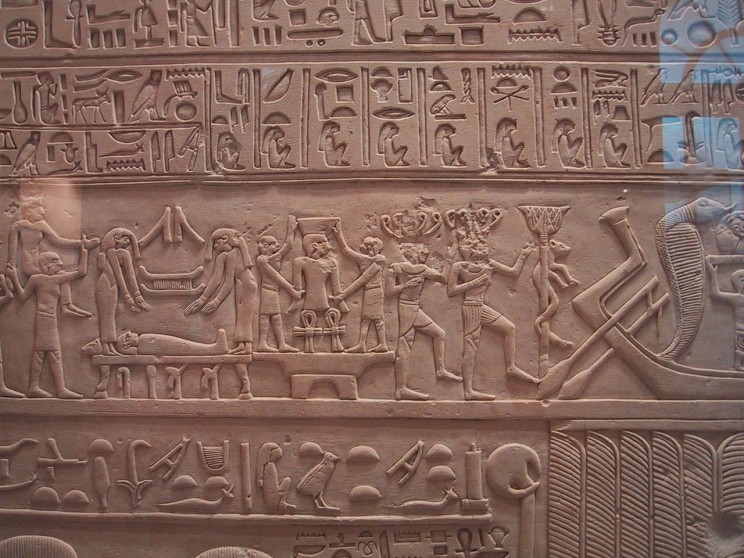
The origin of bear and beaver from brown, though highly probable, is not absolutely assured, but the derivation of the Greek word phryne “toad” (stress on the first syllable) can hardly be put into question. Phryne looks like a perfect cognate of brown. (The famous hetaera Phryne is said to have received this nickname for her sallow skin, but other prostitutes were often called the same, and I have my own explanation of this fact; see below.) Toads, detested by some for all kinds of reasons, have occupied a conspicuous place in the superstitions of the whole world, beginning with at least the ancient Egyptian times. In Egypt, far from being shunned, they stood for fertility, and an amulet in the form of a toad supposedly replicated the uterus. Hequet was a goddess with the head of a frog.
Stories about frogs and toads are countless. One is especially famous. It is about a young man (prince) marrying a frog, which turns into a beautiful maiden. The Grimms knew a short and uninspiring version of this story (it is the opening one in their collection). In it the frog that insists on sleeping in the girl’s bed becomes a handsome prince, which is a variant of “Beauty and the Beast”; as a rule, in such tales the frog or the toad is a female. I would like to suggest, that the nickname Phryne had nothing to do with the hetaera’s skin. All other prostitutes who were called this could not have had the same tint. Since in the popular imagination toads and fertility went together and since Egyptian mythology and beliefs exercised a strong influence on the Greek mind, calling prostitutes toads would have made good sense.
Thus, as we can see, toads (brown creatures) were associated with things bad and good. On the one hand, they were feared for their supposed ugliness and identified with witches. On the other, they were venerated and thought to promote fertility. In that capacity, they frequently received votive offerings. From Egypt we should go to the British Isles, for whose sake I have told my story. As far as I can judge, no accepted etymology of brownie “imp” exists. The books at my disposal only say that brownies, benevolent imps, originated in Scotland and were brown. The earliest citations go back to the early seventeenth century. I have as little trust in brown brownies as in the brown-skinned Phryne among the Greeks. The name must have had magic connotations, but whether positive or negative is open to question. As time goes on, such creatures often change their attitude toward the houses they haunt. They can be friendly if treated well and hostile if offended. By contrast, brownies, chocolate cakes with nuts, are always brown and sweet (chocolate-colored, by definition).
My second example is literary. In Dickens’s novel Dombey and Son, Mr. Dombey’s little daughter Florence is abducted by an ugly old rag and bone vendor. When the girl asks the woman about her name, it is given to her as Mrs. Brown and amended to Good Mrs. Brown. “She was a very ugly old woman, with red rims round her eyes, and a mouth that mumbled and chattered of itself when she was not speaking.” This is how she introduced herself to Florence: “…don’t vex me. If you don’t, I tell you I won’t hurt you. But if you do, I’ll kill you. I could have killed you at any time—even if you was in your own bed at home.” I am sure somewhere in the immense literature on Dickens the folklore of Mrs. Brown was explained long ago. In any case, Dickens must have had a reason for calling the witch Mrs. Brown and adding ominously the ironic epithet good to the name, to reinforce the impression.
And here is a final flourish for today. I will be grateful for some reliable information on the origin of the last name Brown ~ Braune. Dictionaries say that the name goes back to the color of its bearers. I find this explanation puzzling. It is as though thousands of our neighbors were bears, beavers, and toads.
To be continued.
The post A Study in Brown and in a Brown Study, Part 1 appeared first on OUPblog.
Blog: Jennifer Wylie's Blog (Login to Add to MyJacketFlap)
JacketFlap tags: dog, Brown, giveaway, tour, Featured Authors, Brown Goes Full Steam Ahead, Penny Dread Three Anthology, Add a tag
Brown and the End of the Line
Kansas, 1900
By J. A. Campbell
Part Four
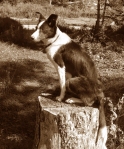 “Call off your dog, mister,” the sheriff said.
“Call off your dog, mister,” the sheriff said.
Growling more loudly, I crouched to the floor and glared at him.
“Brown, easy. It’s all a misunderstanding.”
I continued to glare, but I quieted my growl.
“She won’t hurt you, and I’m not worshiping the devil.”
The sheriff slowly holstered his gun and grabbed Elliott’s arm. “We’ll just see about that.”
“Ask the conductor. I’m trying to stop the ghost. We got one in Miller, Colorado. Wire Sheriff Tolbert.” Elliott smelled afraid and sounded desperate.
I stifled another growl.
“Time enough for that. Let’s go.” The sheriff shoved Elliott in the back, making him stumble down the narrow hallway. The priest followed and I stayed behind them, not letting Elliott out of my sight but staying far enough away that they wouldn’t be able to grab me. A few passengers stared as we marched past, but no one said anything. Though I was more concerned about Elliott, I didn’t forget the reason we were on the train and I kept my nose alert for ghost smells.
“Sirs, please, I’m here to hunt the ghost. I must get back to my room. It could be here any minute.” Elliott stopped and turned toward the sheriff and the priest.
“Son, there’s no such thing as ghosts.”
I couldn’t understand why the sheriff called Elliott son. He wasn’t that much older than my human. The priest on the other hand looked very old, with thin white hair and lines on his face like humans got when they were older.
“Yes….” Elliott’s reply was drowned out by a sharp screech that would have set me to barking if I’d still been on my feet, but the train lurched at the same time and I went sprawling, hitting the back of the priest’s legs and knocking him into the sheriff.
Elliott stumbled into the wall but stayed on his feet. He stared at the fallen men in shock and I had to bark to get is attention.
Run! I would have shouted at him if I could.
“Of course.” He seemed to know what my bark meant and sprinted past the fallen men before they could regain their feet.
Running close behind him, I got a strange feeling and, even though I knew I shouldn’t, I darted forward and grabbed Elliott’s ankle with my teeth and sent him sprawling.
“Ow! Brown, what are you doing?”
Gunshots rang out behind us and an eerie howl rattled my teeth. Something white shot by overhead. It seemed brighter than the lights in the hallway and it rattled the glass as it raced past.
“Good girl, Brown. I should know better than to question you.”
Women screamed up ahead.
“Go, get the ghost. See if you can push it back to our room.”
I jumped over Elliott’s back and I heard him get to his feet and start running as I chased after the ghost. It had made it to the dining car where a few people were enjoying an evening snack. Well, they had been enjoying it, but I smelled musty-ozone everywhere and the walls dripped with ghost slime. One woman was having hysterics and I could smell the ghost all over her and she looked wet with slime too.
Despite all the slime, the ghost was not in the dining car anymore. I barked, seeing if it would come when I called. No luck, but screams from the next room down let me know the ghost was still there, and if I hurried….
***
Be sure to check out David Riley – http://sftrails.blogspot.com/ tomorrow for Part Five!
The Schedule:
Intro – June 11th – J. A. Campbell – https://writerjacampbell.wordpress.com/blog/
Part 1- June 12th – Sam Knight – http://samknight.com/
Part 2 – June 13th – Bea’s Book Nook – http://beasbooknook.blogspot.com/
Part 3 – June 14th – Amaleen Ison – http://www.amaleenison.com/
Part 4 – June 15th – Jen Wylie – http://jlwylie.wordpress.com/
Part 5 – June 16th – David Riley – http://sftrails.blogspot.com/
Interview with Brown – June 17th – Anne Michaud – http://annecmichaud.wordpress.com/
The Contest:
Follow the link to enter a contest to win a copy of Science Fiction Trails 10 in which Brown battles Martians. US only I’ll send the winner a signed copy, the rest of the world, you have to take an unsigned copy, sorry. You gotta be willing to give me your address though Alternately the winner can chose a Kindle copy. Contest runs from June 11th through June 30th. I’ll pick three winners.
 Bios:
Bios:
Brown – Brown is a Border Collie who hunts ghosts, and other things as it turns out, with her human, Elliott Gyles. You can find out more about her adventures here: https://writerjacampbell.wordpress.com/eye-of-the-dog/
Julie – Julie writes fantasy novels. When she’s not out riding her horse, she can usually be found sitting in front of her computer with a cat on her lap and her dog at her side. Read more about her other stories here: http://www.writerjacampbell.com
Excerpt from Brown Goes Full Steam Ahead in the Penny Dread Three Anthology:
I quickly grew used to the shrieking whistle and the rumble of the steam engines that vibrated my paws constantly. We stood in the front of the ship while it rumbled down the Mississippi. Occasionally water would splash my nose and the scents that filled the air kept me busy with all the stories they told. I was almost disappointed when Elliott told me it was time for our performance. The sun was low in the sky and the people who worked on the boat said the ghost, they referred to it as a she, usually came out during the performances or at night when the passengers would stroll on the decks.
Blog: Mishaps and Adventures (Login to Add to MyJacketFlap)
JacketFlap tags: books, cute, love, diary, brown, amulet, Wimpy Kid, ABRAMS, Add a tag
Blog: Mishaps and Adventures (Login to Add to MyJacketFlap)
JacketFlap tags: The Third Wheel, design, brown, Diary of a Wimpy Kid, heartbroken, cheese touch, Add a tag
Blog: DIANE SMITH: Illo Talk (Login to Add to MyJacketFlap)
JacketFlap tags: green, pumpkins, brown, leaves, weekend., Add a tag
Getting tired of painting with so much green and brown - luckily today was orange (and a little green).
Notice anything new? After I'd submitted my original proposal, I'd thought about adding some leaves around the pumpkins and along what will be a vine between the plowed field and the band of light green along the bottom. So, I did...and I'll probably add a few more.
It's a 3-day weekend - no soccer games, to events! Just time to relax and paint, paint, paint! Oh, and probably BBQ.
Blog: the enchanted easel (Login to Add to MyJacketFlap)
JacketFlap tags: girl, cute, flowers, animals, baby, elephants, brown, pink, whimsical, original paintings, bedding, bows, nursery art, the enchanted easel, nicole's nursery art, baby girls, Add a tag

Blog: Monday Artday (Login to Add to MyJacketFlap)
JacketFlap tags: baking, watercolor, brown, Add a tag
Blog: Schiel & Denver Book Publishers Blog (Login to Add to MyJacketFlap)
JacketFlap tags: booksellers, Brown, The Times, Little, Charlotte Williams, Rights deal, James Gill, Clare Smith, Kevin Maher, The Fields by Maher, Add a tag
Little, Brown has acquired a debut novel by Times critic, columnist and features writer Kevin Maher, with publishing director Clare Smith snapping up her first title for the imprint in a hotly-contested four-way auction.
Add a CommentBlog: Schiel & Denver Book Publishers Blog (Login to Add to MyJacketFlap)
JacketFlap tags: People, booksellers, Brown, Little, Orbit, Charlotte Williams, moves, Anne Clarke, Emily Gee, Gail Z Martin, James Lovegrove, Jenni Hill, Solaris Books, Add a tag
Little, Brown science fiction and fantasy imprint Orbit has appointed Jenni Hill, previously of Solaris Books, as commissioning editor.
Hill will report to editorial director Anne Clarke, and will take up her post on 31st October. While at Solaris, she worked with authors including James Lovegrove, Gail Z Martin and Emily Gee.
Add a CommentBlog: Schiel & Denver Book Publishers Blog (Login to Add to MyJacketFlap)
JacketFlap tags: booksellers, Brown, Penguin, Little, Falklands War, Charlotte Williams, The History Press, Add a tag
Publishers including Penguin, Preface, Little, Brown and The History Pres, have enlisted a battery of titles to commemorate the 30th anniversary of the Falklands War next year.
The History Press is following up its release of The Silent Listener: Falklands 1982—The Inside Story of British Electronic Surveillance and Intel Controversies by Major D J Thorp earlier this year with Ordinary Heroes: Untold Stories from the Falklands Campaign by Christopher Hilton.
Add a CommentBlog: Schiel & Denver Book Publishers Blog (Login to Add to MyJacketFlap)
JacketFlap tags: People, booksellers, Brown, Little, Charlotte Williams, Angry Robot, moves, Add a tag
Angry Robot has appointed Little, Brown online marketing manager Darren Turpin to the role of marketing and digital manager.
Turpin will join the company on 7th November and report directly to Marc Gascoigne, publishing director of the science fiction and fantasy imprint. He will work on promoting all Angry Robot titles, as well as developing some new digital initiatives.
Add a CommentBlog: the fabled needle | an art, craft and sewing blog! (Login to Add to MyJacketFlap)
JacketFlap tags: fall, Sewing, green, brown, black, Add a tag

I hope everyone had a nice weekend! Because of our Labor Day holiday here in the U.S. I was able to finish up some sewing that has been sitting around since my last fall outfit post.
Once again, this outfit is 1930s-inspired; perhaps it’s vaguely Carnivale-esque? The blouse is made up of a muted mint green shirting, off-white cotton-silk voile and embellished with a black silk satin ribbon bow (that’s pinned on and can be removed). The skirt with large patch pockets is made from a tan/black/orange glen plaid.

The top pattern is McCall’s M5977. Remember how I said I thought the armhole ruffles were weird? Well, I decided to add them for this version but I redrafted the ruffles so they would be the least narrow under my arms (which is more flattering in my opinion). I knew going in that this shirting fabric was not ideal for a pullover style top; it’s a little stiff and would be better suited to a button-down shirt. I was stubborn and envisioned it being made into this very blouse anyway. The shirt is meant to be tucked in so to reduce the bulk around my waist I added darts to both the front and back, keeping in mind that I still needed to be able to slip this on over my head!

The skirt fabric is a really soft cotton, not the wool you would expect. (So soft in fact that Spoo Kee is sleeping on top of it as I write this.) I kept the design really simple with patch pockets cut on the bias for a slight contrast. The pockets are lined with self fabric that is cut with the grain (for stability).

For a bit of fanciness I lined this skirt with silk charmeuse. I have to say, I love it! By far so much nicer than polyester or acetate lining. It feels like wearing a nightie underneath. And yes, you may notice that I used a navy blue zipper instead of black. That is simply because I had forgotten to get a black zipper and the fabric store was closed and I did not want to wait! Ah, impatience.
Have you started your fall sewing yet?
Blog: the fabled needle | an art, craft and sewing blog! (Login to Add to MyJacketFlap)
JacketFlap tags: Sewing, pattern, brown, blue, 1930s, blouse, skirt, toile, Add a tag

All I want to do is sew clothes. I have many ideas for other crafty projects, including shop stuff, but at the end of the day I just want to make a skirt or cut out a new blouse. Life has been a bit crazy lately and sewing for the pure fun of it is my therapy, I suppose.
The clothes I’m working on are fall items I can wear now. Because, you know, it’s not really going to get chilly here ’til late October or so.

Here is a blouse I made combining pattern pieces from McCall’s M5977 and New Look 6022. I shortened the sleeves, drafted the v-neck and made the bows. I don’t recommend attaching sleeves to bodice pieces meant for a sleeveless top (which is what I did) because the armholes aren’t quite right but I don’t think it’s noticeable and fits comfortably anyway.

The original design had 5 larger, pointier bows going done the front. Even after testing the placement I didn’t get a feel for what it would truly look like until I had made and attached all the bows. (You might be able to see bias tape stitched down the center front on the inside; this was placed there to support the bows.) But I didn’t like it afterall. Don’t know why, it just seemed too stiff or something. So I re-cut 2 of the bows and attached them just near the v.

The skirt is my favorite of the 2. The colors look blown out in the photo where I’m modeling it but the fabric really is so pretty and has a nice, slightly coarse texture. (By the way, I probably wouldn’t wear those shoes with this skirt out and about because they are too orange but I’m currently without dark brown pumps.)
And yes, I used Simplicity pattern 8418 for this skirt. Of course!
I’m so glad it’s Friday. Do you have any fun plans for this weekend?
Blog: the fabled needle | an art, craft and sewing blog! (Login to Add to MyJacketFlap)
JacketFlap tags: autumn, fall, Sewing, fabric, brown, blue, black, Add a tag

For the first time ever I’m planning out my sewing projects for the next season in advance so that they will complement each other. It’s fun in a sewing/fashion-nerd sort of way. I’ve reorganized my fabric stash into fall/winter and spring/summer instead of fabric-type to make it easier to pick out things that work together. As usual I’ve gotten pretty ambitious with what I’d like to make up but at least I’m getting a head start. (I’ve already finished one quick project this weekend and have started another.)
I’m showing you two palettes. There are a lot of browns; no surprise there. The first one consists of pale muted blues and greens and ivory. Toile and houndstooth and dots and cotton velvet.

The second palette is warmer although there is some black in there too. Rust and mauve and mustard yellow brighten up this set. Faux fur and florals here. All of it, naturally, very vintage-inspired. Pretty, faded, old-fashioned prints and textures. I’ve got some ’30s patterns picked out, some from the ’60s (for basic shapes) as well as modern ones too.
Have you started planning or even working on projects for next season yet? Do you like to plan in advance and to what degree?
Blog: Bit by Bit (Login to Add to MyJacketFlap)
JacketFlap tags: birds, Zazzle, Animals, Moleskine, digital, Drawings, owl, Digital Art, brown, Dabbling, pink, floating lemons, corel painter 11, Marker pens, Add a tag
Another one of my doodles, originally drawn in marker pens in my Moleskine Ideas Book and then digitally painted in Corel Painter 11.
I'm a bit behind with everything -- I've been working on a job, trying to sort out the business side of things, and have just completed a clean-out of my computers by reinstalling the operating systems ... always a stressful procedure although this time it went relatively well and I didn't end up bashing my head against any walls. Still, it takes two days to back everything up, reinstall programmes, then transfer the lot back. But it's all done!
I'm itching to lose myself in a good, long, therapeutic coloured pencil drawing, but I'll have to wait another week as I have a long to-do list that's screaming for attention. Priorities. Cheers.
Pink Owl cards and matching gifts are at: Pink Owl at Floating Lemons @Zazzle.
Blog: Steve Draws Stuff (Login to Add to MyJacketFlap)
JacketFlap tags: names, story, personal, writing, business, jokes, comedy, funny, promotion, steven, novak, brown, shoes, haircut, breath, mints, nowack, Add a tag
I’m a terrible promoter.
I really am.
The problem isn’t that I’m lazy, or that I don’t put forth the effort, or that I’m unwilling to put in the time. It’s none of that stuff.
I’m actually not the least bit lazy, my effort-abilities are second to none and I have nothing but time on my hands.
The actual issue is that my personal persona and my business persona get mixed up a lot. A whole lot, actually.
I say stuff I shouldn’t. I put things out there that I should have locked a safe, wrapped in a chain and tossed into the ocean.
As much as it pains me to admit, I’m an idiot.
The fact that I’m writing these very words at this very moment proves I’m an absolute dolt and that I’ll never learn.
Do the followers on Twitter that are interested in my YA novel or my artwork really need to know that I spent the night bent over the toilet due to a nasty bout of food poisoning? Probably not.
Did I tell them? Yep.
Was it necessary to let them know that because of it I spent the entire next day breaking wind like Chris Brown breaks ladies’ faces? Most definitely not.
Was that Chris Brown joke a massive mistake?
You better believe it.
I’m a goof-ball and I don’t know when to stop.
I spend so much time cracking wise and making you feel uncomfortable with awkward-delicious nuggets about my personal life that I sometimes forget I’m trying to sell you something.
Then the bill collectors come calling. Then my wife shakes her head and I pull out the lining of my pockets and shrug my shoulders. Then she hops on-line and types the words “divorce attorney” into Google.
It’s a vicious cycle.
So how do I plan on solving this little problem of mine?
I have to get serious. I have to get more professional.
I’ll need a briefcase of some sort . Maybe some papers to put in it.
Wait, wait, wait - maybe I don’t need the papers at all. I mean, what are the chances anyone will actually ask to see what’s inside, right?
Combing my hair, putting on a suit and brushing my teeth more than once every other day just isn’t going to cut it anymore. It’s not enough. I have to take things to the next level. I’m going to have to make some drastic lifestyle changes.
I’ll need to straighten that hunch in my back and smear that sloppy-creepy grin off my face.
Maybe I’ll even shave.
I’ll have to mind my P’s and Q’s while making sure my F’s and U’s are never allowed in the same sentence together.
I’ll need to be better than the sum of my parts and better than the sum of the sum of those parts.
I’ll have to blog about books and writing, and the writing process and the process of writing.
Speaking of my blog, I’ll need to maintain it a bit more diligently. I guess I should watch that I don’t accept a friend request from anyone and everyone on Facebook. I should also try and make sure current and prospective clients don’t catch wind of my uncontrollable post-puke wind breaking in one of my many unnecessary status updates.
Breath mints will be important.
New shoes too. New shoes are a given. Shoes are the first thing people look at. I heard that somewhere.
No more gobbling on burgers so stuffed with goop the juices leave stains on my shirts. Nope – gonna have to put the kibosh on that one.
I’ll need some new shirts as well.
Maybe I should change my name? It might be smart to change it to something a little more professional sounding.
Max Hardcopy?
How about, Patrick Gitstuffdun?
No, wait…Stephen Nowack.
No one commands respect like a Nowack.
Or maybe I shouldn’t do any of this nonsense.
Stephen Nowack? Seriously? That’s just silly.
Breath mints? That’s even sil
Blog: illustration pages (Login to Add to MyJacketFlap)
JacketFlap tags: Brown, facebook pages, Wardell, Add a tag
It's difficult for artists to come up with ways to attract visitors and "followers" to their Facebook pages. There's no doubt about it. After all, artists don't have the budgets big companies have to offer contests, hold sweepstakes or have elaborate Facebook apps built. Admittedly it can be down right frustrating to come up with ideas to generate traffic to your page.
But if you bend your noodle long and hard you can come up with some great ideas. Take illustrator Wardell Brown as an example. His idea is simple, but effective and fun. He uses his natural talent to attract people to his Facebook page. Who would have thunk it?
Every Friday Wardell selects one person to draw from photos submitted to him, and that drawing is posted the following Monday on his blog and Facebook page. Simple right? He calls it, GET D!RAWN. All you have to do is send your picture to him for consideration, and include your Facebook profile name or Twitter profile name. There are a few basic rules you must follow in order to be selected - one of them being the obvious - you must follow Wardell on Twitter and/or follow his Facebook page. Wardell started this back in October of 2010, and it seems to have been pretty successful for him. He's completed several drawings to date and has 390 followers as of the writing of this article. It doesn't hurt that Wardell is a very talented illustrator. But we all know from expereince that talent alone doesn't always move you into the spotlight. Creative marketing helps. Wardell Brown seems to have a pretty good handle on both.
Remember - be creative and have fun with it. And when you come up with a great idea that's attracting followers to your page, drop us a line to tell us about it.
Blog: the fabled needle | an art, craft and sewing blog! (Login to Add to MyJacketFlap)
JacketFlap tags: Sewing, brown, Vintage, dress, navy, lace, Add a tag

I know, the last time I was going on and on about dresses it was about little smocks and such. But you’ll be proud of me because one of these dresses (the above one, actually) is one that I started a year ago, so at least I’m making myself finish what I start!
My intention was to wear this number last Thanksgiving in Texas during our grand “series of fortunate events.” And while my husband’s family was planning most of the reception activity I was far too frazzled to focus on sewing this dress, especially when the sleeves stopped cooperating. I finally decided, a year later, to finish it or give it up which was enough motivation to figure out the sleeve issue (ones I drafted myself) and apply the finishing touches.
This is Du Barry 2506B. Hands down, one of my favorite patterns. The sleeves in real life were too puffy for me so that’s why I had to change them. The bow at the neckline was not quite as sweet as the one shown so I used this corally-colored satin ribbon instead. At first I thought, perhaps, it looked too much like a Girl Scout or pilgrim dress but in these photos I quite like it. The dark brown dotted swiss is really soft and so comfortable. I omitted the belt because it looks fine with out it but I can always make one later on.

The next dress is quite different:

I had to blow out the photos because the fabric is so dark; it’s a midnight blue rose-pattern lace. It’s the kind of lace that has a nice weight and drape and may be a cotton blend (similar to my wedding dress). I ended up using a slightly darker Petersham (grosgrain) ribbon and kept the look monochromatic.
This style is a departure from my normal look, at least in terms of the sleeves. I’ve seen them called “wingsleeves” before although I’m not sure if that’s the official term. Very popular in the 1940s and ’50s they always struck me as being a little bit masculine or angular and therefore was never that appealing. Over the last few years, however, quite a few vintage patterns with such sleeves have found their way into my stash and I might as well give them a try!
0 Comments on Dress Parade {Holiday Part 1} as of 1/1/1900
Blog: illustration pages (Login to Add to MyJacketFlap)
JacketFlap tags: illustrator, Brown, illustrators, B, facebook pages, Wardell, Add a tag
Wardell "WAR" Brown is breaking out today on IP so you better be ready. Wardell's gloves are off and he's creating some killer vector art. Babes, brats, business men - what do you need? - cause WAR creates them all. And besides his cool computer illustrations, Wardell also gives us a peek into his sketchbooks and offers up some great paintings and other merchandise for sale on his website.
Wardell Brown is a freelance cartoonist and comic book artist hailing from the great state of California. He has a contemporary take on classic cartoon styles which he classifies as neo-retro. His influence is 1960's advertising cartoon art but he's laying down his own cartoon art with rockin' colors and kicked up concepts.
There's no doubt you'll want to spend some time with Wardell Brown's art. His illustrations look awesome on t-shirts, posters and skat
Blog: Sarah McIntyre (Login to Add to MyJacketFlap)
JacketFlap tags: cheltenham, gourlay, simmonds, niffenegger, workshops, brown, festivals, Add a tag
If someone had asked me, which writers would you like to see gathered all in one place? Wish hard! Well, yesterday at the Times Cheltenham Festival of Literature went a long way toward fulfilling my wish. On the train back, I was reading my newly purchased graphic novel by Audrey Niffenegger, The Night Bookmobile, which wraps itself around the joys and perils of finding a book heaven, and yup, that's Cheltenham. And not only were there amazing books and book creators milling about, but we got to make comics!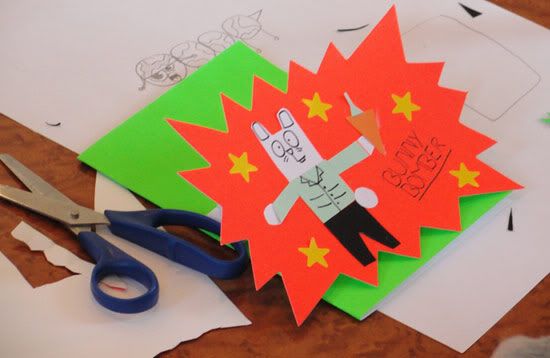
I was dead chuffed to see the Vern and Lettuce poster I'd designed displayed prominently all over town. I'm really proud of it.
Click on the pic or here to see an enlarged version.
I led two events, one of which was a two-hour comics workshop. We went for BOLD cover designs, based on an earlier workshop I did for HyperComics in Battersea Park. We had some great results!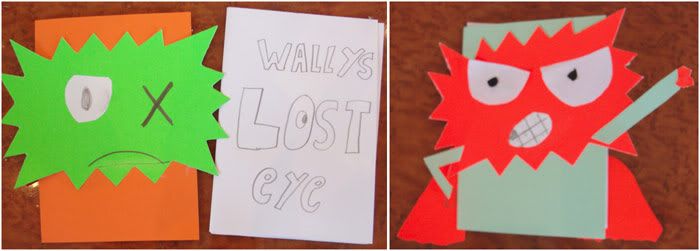
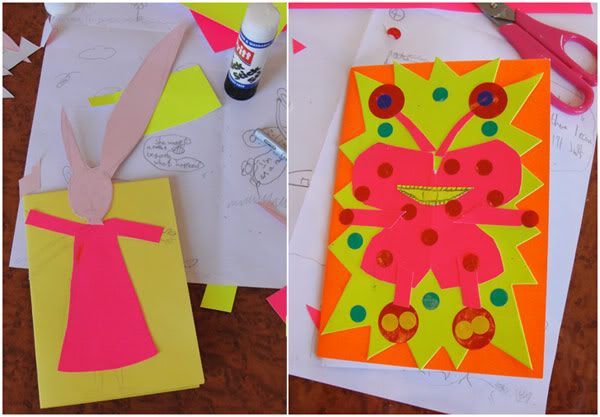
I didn't manage to get many photos of it, but before the participants made their own comics, we got our stories moving with an interactive Comics Jam session. Here's one, starring a slug, that made me laugh:
Panel 1: 'Good evening, garçon, a glass of Chardonnay, please.' 'Sacré bleu! A SLUG!!'
Panel 2: 'Can I at least get takeaway?' 'And don't come back!'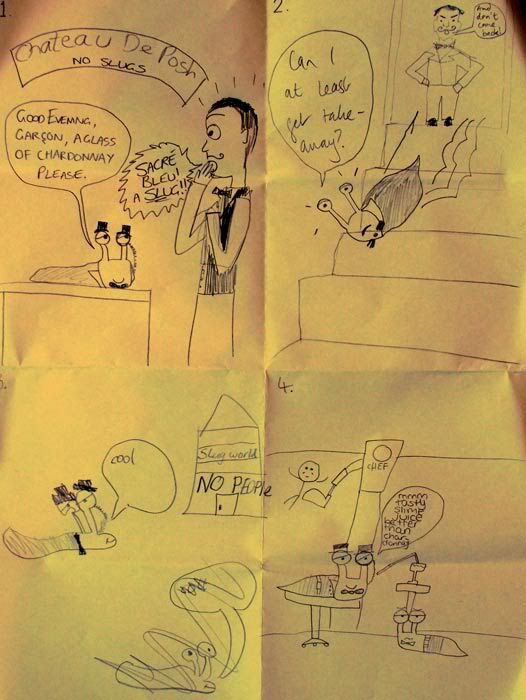
Panel 3: 'Cool' [Slug World: NO PEOPLE] Panel 4: 'Mmm, tasty slime juice. Better than Chardonnay.'
I was very taken with this wine-glass chandelier at the Hotel du Vin: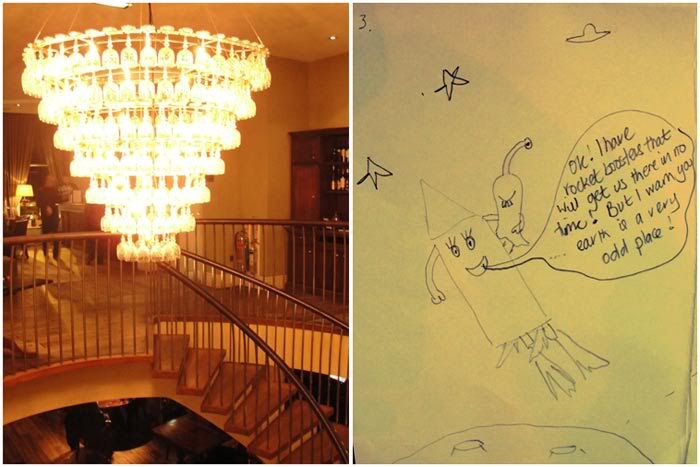
The best part about these festivals are the people you meet: catching up with old friends and meeting new ones. Here's the wonderful Ben Haggarty, who works as a storyteller; despite the fact he's used to telling stories, not writing them, he came up with the text for the most magnificent book of the year (and quite possible the best one, too), Mezolith. 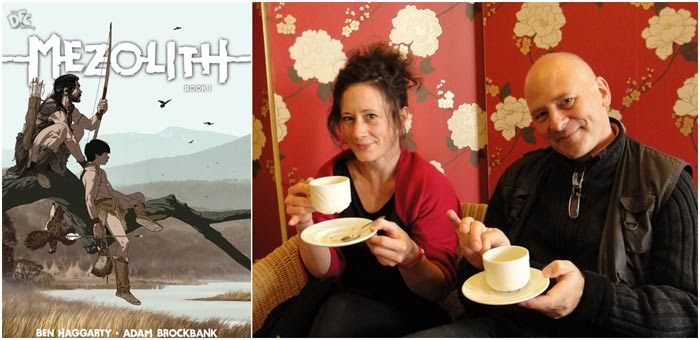
'Mezolith', published by David Fickling Books in the DFC Library series. Storyteller Ben Haggarty with his partner Katie
YouTube link
For weeks I'd been looking forward to dinner the night before events, with people from my fab David Fickling and Scholastic team, and with Martin Brown (whom I'd met for the first time at the Edinburgh lit fest) and Damian Kelleher, who's done a bunch of graphic design work with me. In theory, it's an easy journey to Cheltenham Spa from Birmingham (where I'd done a signing at the British International Comics Show). But I hadn't reckoned with the abyss of failure that is Birmingham New Street station. When I realised I was
View Next 20 Posts



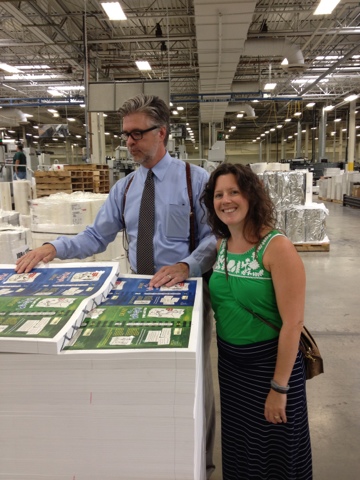

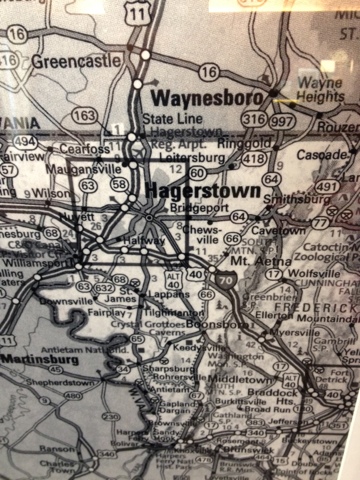


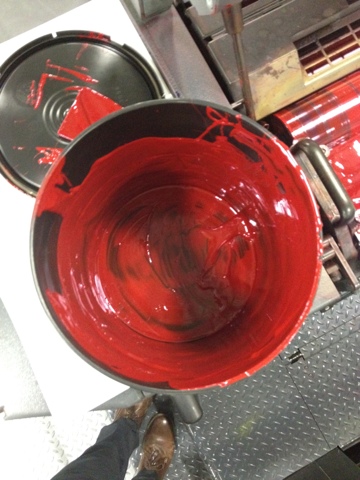


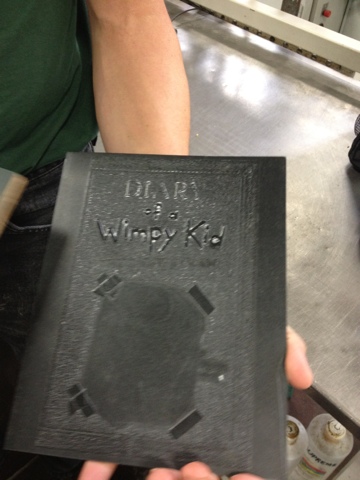
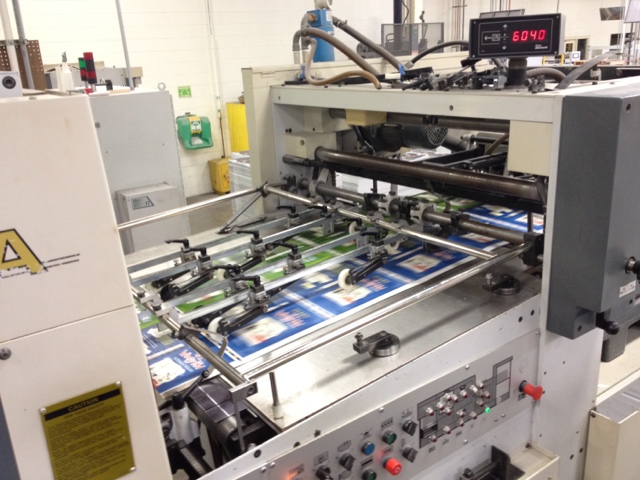










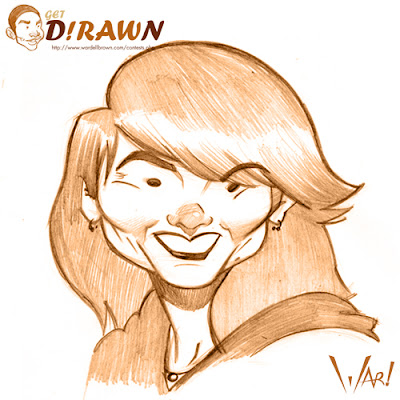



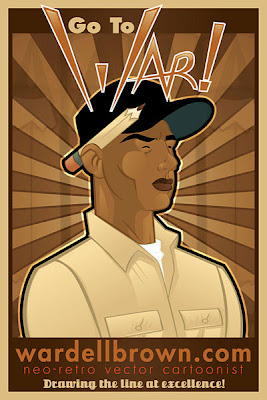







Thanks for letting us be on press with you.
I love being on press - it's been a long time.
(Hi Michael! Hi Allison!)